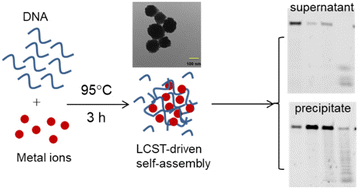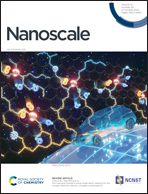Protection of DNA by metal ions at 95 °C: from lower critical solution temperature (LCST) behavior to coordination-driven self-assembly†
Abstract
While polyvalent metal ions and heating can both degrade nucleic acids, we herein report that a combination of them leads to stabilization. After incubating 4 mM various metal ions and DNA oligonucleotides at 95 °C for 3 h at pH 6 or 8, metal ions were divided into four groups based on gel electrophoresis results. Mg2+ can stabilize DNA at pH 6 without forming stable nanoparticles at room temperature. Co2+, Cu2+, Cd2+, Mn2+ and Zn2+ all protected the DNA and formed nanoparticles, whereas the nanoparticles formed with Fe2+ and Ni2+ were so stable that they remained even in the presence of EDTA. At pH 8, Ce3+ and Pb2+ showed degraded DNA bands. For Mg2+, better protection was achieved with higher metal and DNA concentrations. By monitoring temperature-programmed fluorescence change, a sudden drop in fluorescence intensity attributable to the lower critical solution temperature (LCST) transition of DNA was found to be around 80 °C for Mg2+, while this transition temperature decreased with increasing Mn2+ concentration. The unexpected thermal stability of DNA enabled by metal ions is useful for extending the application of DNA at high temperatures, forming coordination-driven nanomaterials, and it might offer insights into the origin of life on the early Earth.

- This article is part of the themed collection: Emerging concepts in nucleic acids: structures, functions and applications


 Please wait while we load your content...
Please wait while we load your content...